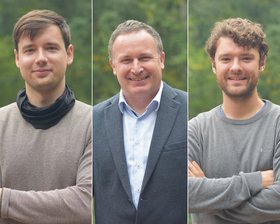Silicon flexes its muscles: How nature is inspiring completely new material concepts for the technology of tomorrow
01.10.2020

Smartphones, laptops, smart watches: The chemical element silicon is found in every electronic component and computer chip, no matter how small. Silicon also gives its name to Silicon Valley, the home of many technology companies. Scientists from Hamburg have now succeeded in giving silicon muscle power. This new property enables the material to convert electrical signals into mechanical movements for the first time. As the team writes in the journal "Science Advances", the new hybrid material thus offers completely new perspectives for the chip-based technologies of tomorrow.
In order for the loudspeaker in a smartphone to work, so-called actuator materials are required. These perform small movements in the micrometer and nanometer ranges electrically and very precisely, causing air, for example, to vibrate. Until now, silicon could not perform such functions. "To change this, we artificially imitated what nature has already achieved in biomaterials such as bones or teeth through a clever combination of soft and hard matter," says Patrick Huber from Hamburg University of Technology (TU Hamburg). For this purpose, his team equipped the smallest nanocanals in "hard" silicon, which can form spontaneously in huge numbers, with the artificial, environmentally friendly and "soft" muscle polymer polypyrrole. "We have succeeded in causing these muscle molecules and thus the entire silicon skeleton of the hybrid material to expand under electric voltage and then contract again," explains the physicist. What is particularly exciting about the new material is that in an aqueous environment only very small electrical voltages are required for the actuator function. They are similar in magnitude to those used in many living systems to conduct stimuli and control movement. "This makes the hybrid material particularly promising for applications in biological or bio-medical systems," explain Manuel Brinker, lead author of the paper, and co-author Guido Dittrich, both PhD students at the TU Hamburg.

In addition to silicon with muscles, many other new material systems are being explored in the Collaborative Research Center SFB 986 at the TU Hamburg. These are also part of the newly established Center for Integrated Multiscale Materials Systems, CIMMS for short, which received funding of almost four million euros over a total of four years from Hamburg’s Ministry of Science, Research, Equality and Districts in January 2020. In addition to the TU Hamburg, researchers from the University of Hamburg (UHH), the Deutsche Elektronen-Synchrotron (DESY) and the Helmholtz-Zentrum Geesthacht (HZG) are working together on the project. Patrick Huber recently became head of the research group "Physics of Materials and High-Resolution X-ray Analytics of the Structural Dynamics and Function of Matter" in CIMMS within a cooperative professorship between DESY and TUHH with a link to the Center for Hybrid Nanostructures CHyN at UHH.
For further information see: https://advances.sciencemag.org/content/6/40/eaba1483
Huber Lab Webseite: https://huberlab.wp.tuhh.de
SFB986-Webseite: https://www.tuhh.de/sfb986
TUHH - Public Relations Office







